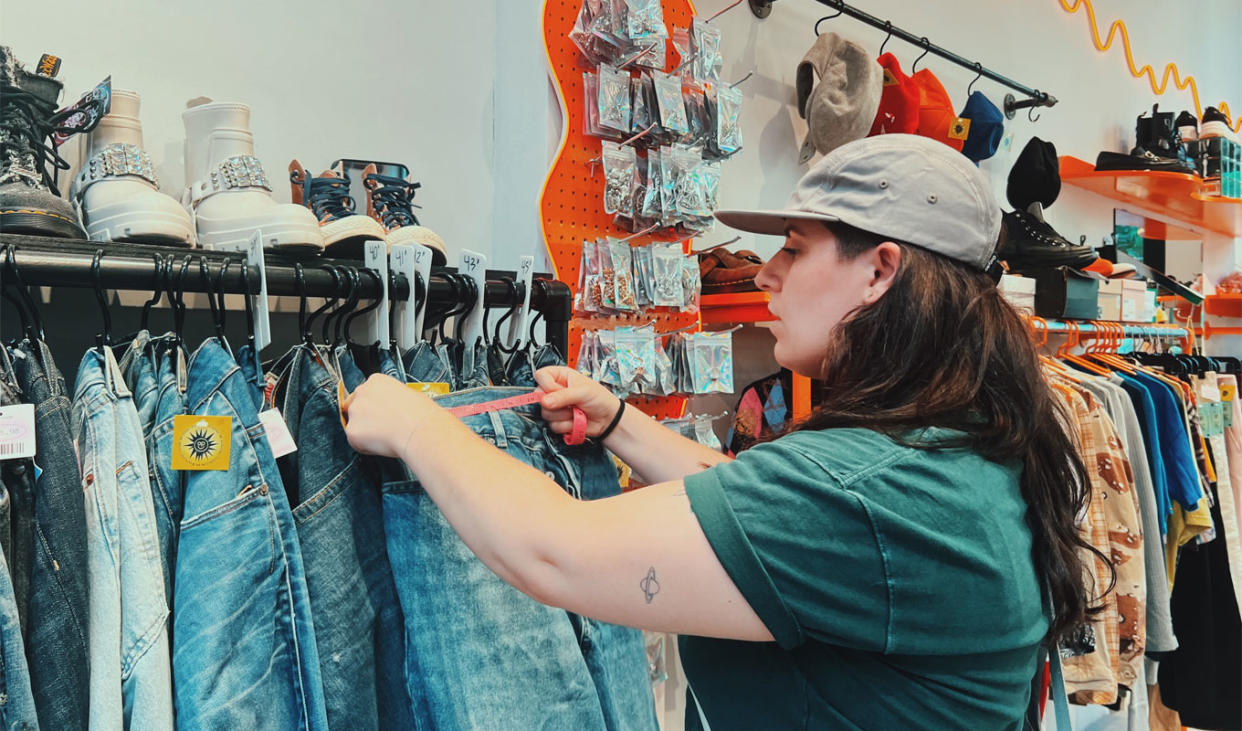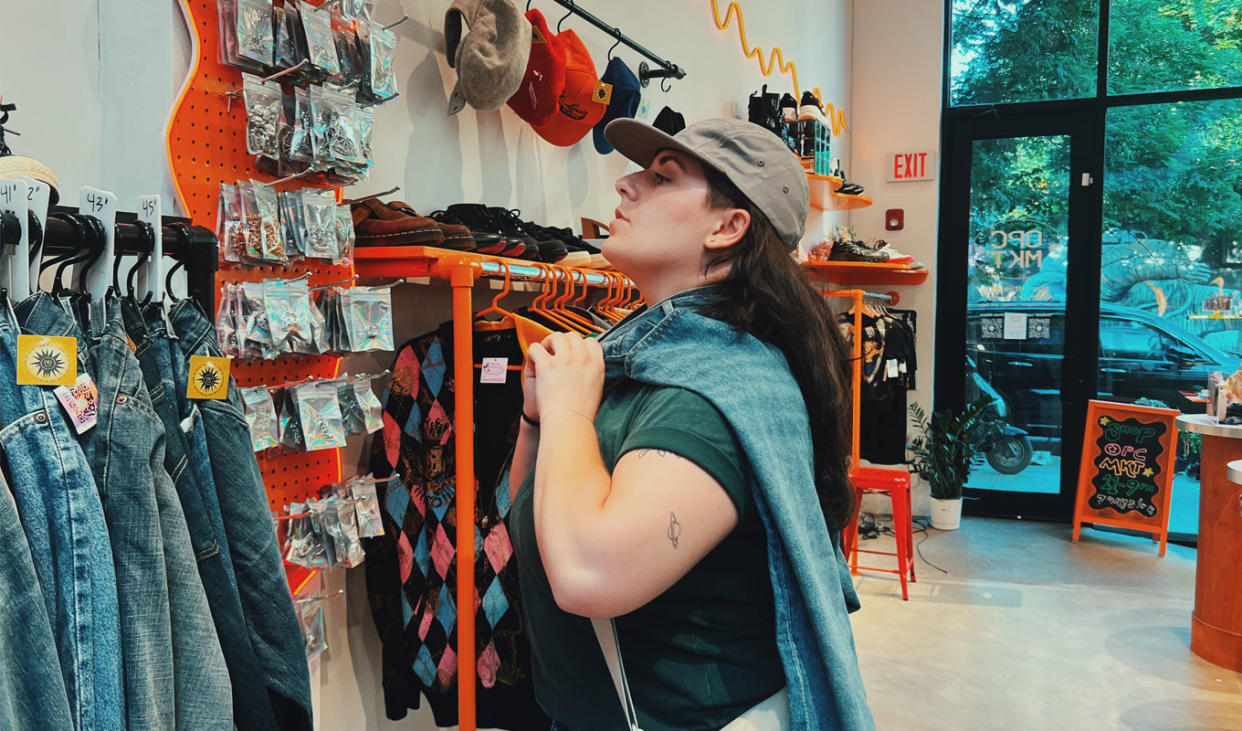I'm Nonbinary and Here Are 5 Rules of Shopping in the Men’s Section That Anyone Can Use
PureWow Editors select every item that appears on this page,, and the company may earn compensation through affiliate links within the story You can learn more about that process here. Yahoo Inc. may earn commission or revenue on some items through the links below.
Read the original article on Purewow.
The first time I ventured into the men’s section with a discerning eye, I was a femme—a term used by lesbians who embody femininity in a non-heteronormative way. I mixed mini skirts and combat boots, extravagant eye makeup with bold blazers and chunky rings with delicate slip dresses. And at the time, I also thought I was a woman. Oh, how wrong I was…
Now at a ripe 27 years old, I’ve been out as nonbinary for three years and shop almost exclusively in the men’s section (with the exception of fun accessories). But I wasn’t always comfortable venturing into forbidden taboo territory—the land of the man, if you will.
I was about 22 when I really started to experiment with my style and presentation, slowly but surely adding more masculine pieces of clothing into my closet the past five years. So much so that nearly 99 percent of the things I’ve purchased or thrifted have come from the stores or sections marketed toward men or are worn in a masculine way. That being said, I’ve become quite the expert when navigating the men’s clothing stores both in person and online, which is why I’ve pulled together my five best tips for shopping in the men’s section no matter what kind of body you were born in.
1. Bring a Tape Measure (or, Better Yet, Know Your Measurements)

Image: Joey Patt/Edit: Delia Curtis
Men’s clothes are unique in that they use a standard measuring system to determine the sizes of their items, not an arbitrary one that varies from brand to brand. Instead of being a size 3 at one store and an 8 at another or a large in one and 2XL in another, you’ll be looking at the numbers of inches–sometimes centimeters–to determine the size of your clothing. When men’s pants say they’re a 38, that means 38 inches around the waist.
With men’s clothes, you’ll want to know the following measurements of your body in both inches and centimeters. Write them down on a piece of paper to tuck away in your bag or pocket while shopping. Alternatively, you can keep a cloth or small retractable measuring tape in your bag or pockets for easy accessibility in-store while browsing the racks, especially if you’re unfamiliar with the men’s section to begin with:
Neck: The circumference of your neck for collars on shirts
Shoulder: The length from shoulder to shoulder, crossing over the back of your neck
Sleeve Length: The length from the top of the shoulder to the wrist
Center Back Sleeve Length: The length from the center of your back to one of your wrists
Chest: The circumference of your chest from your back all the way around to the fullest part of your chest
Waist: The circumference of the smallest part of your waist
Seat/Hip: The circumference of the widest part of your hips, measuring over the fullest part of your butt
Inseam: The length of your pants from the crotch to the ankle bone
2. Get to Know What Silhouettes You Like
Something to be aware of is that men’s clothes will fit differently than women’s clothing. Men’s shirts will typically be longer and wider than standard women’s shirts and men’s pants will often be longer in the leg, wider in the waist and sometimes will be smaller in the thighs. Figuring out the ratio of men’s measurements to your measurements in women’s clothing (per brand) will help you figure out how to find the equivalent sizing when you shop the men’s section.
It’s also worth noting that in addition to knowing your measurements, you’ll want to be aware of the general fit of men’s garments and how they’ll lay on your body. Typically, men’s garments will have a looser, boxier fit. Think: wider shoulders, thicker arms and biceps, baggier legs and slimmer thighs. Understanding how the clothes will lay on your body, as well as how to size up and down, will help you find your perfect fit when perusing the men’s section. For example, men’s inseam lengths will generally be longer than women’s, so you may notice that you’ll need to look for a shorter inseam length when shopping the men’s section.
Air Threads, a men’s made to measure shirt brand that utilizes various kinds of fabrics and styles to create customized looks, helps to break down the types of fits you may see out in the wild as you journey through the men’s section:
Shirt Fits/Styles
Pants
Once you determine what kinds of shirt and pants silhouettes that you prefer, see how those kinds of fits will lay on your body. Will they be a bit too tapered? Too baggy? Extra long? That leads me to tip number three…
3. Become BFFs with Your Tailor
In addition to getting to know the fit of men’s clothes, you’ll want to be comfortable asking your tailor to adjust items to your measurements that don’t immediately fit. See what kinds of alterations that your tailor offers. Can they shorten leg lengths? Bring in the waist of a garment? Loosen the collar? Knowing what their capabilities will allow you to ask for the fit you want. I often have to get my pants’ waist taken in because I have larger thighs and often have to size up in men’s pants to ensure that they will fit that area of my body. Don’t be shy when inquiring about exactly what you want because ultimately, you are there to get your garments to fit just right.
4. Try the Waist-Neck Trick

Image: Joey Patt/Edit: Delia Curtis
One of the things I swear by is the 2:1 neck-waist rule. So much so that I’ve written about it before. Finding a pair of men’s pants without having to try them on has been a challenge as someone with a big butt and wide hips, but this rule has saved me many a trip to the dressing room when shopping in a pinch or with limited time. This trick can be done anywhere in a store and only requires you wrap the waistband of a pair of pants around your neck to see if they may be able to fit. Typically, the ratio of your neck to waist will be approximately 2:1 give or take a few inches. That being said, when keeping the pants flat together and wrapping the waistband of the pants around your neck, if the ends meet without hugging your neck too tightly, the pants should be a solid fit. Nine out of ten times, this will work, but you may have to adjust the ratio to your body, say 2:1 plus two inches to ensure a pair of pants will fit.
5. Start by Thrifting

Image: Joey Patt/Edit: Delia Curtis
Journeying into the men’s section can be daunting at first. My recommendation is to start by thrifting clothes from the men’s section so you can get a feel for how they fit your body and you can try out many more styles without breaking the bank. You’ll also be able to play around at home with pining the garment, using hemming tape or even cutting it apart without fear of ruining a brand-new garment. Plus, you’ll give new life to something that may otherwise have ended up in a landfill.
Brands That Make Shopping in the Men’s Section a Breeze
If you’re interested in taking a little dip into the men’s section, I’ve listed some of my favorite retailers to shop that make the adjustment that much simpler. They’ve got easy to navigate sites, measurement charts and incredible styles to choose from. Plus, they cater to women as well, so you’ll be able to compare the clothing more easily.
